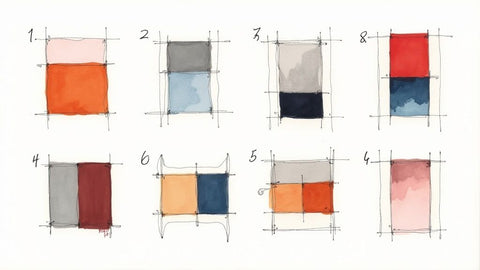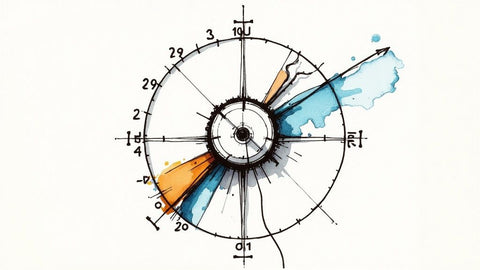If you've ever found yourself in a fabric store wondering, what is quilting cotton fabric, you're not alone. The easiest way to think of it is as the trusty, reliable workhorse of the sewing and crafting world. It's the perfect canvas for your creative ideas—a 100% cotton, plain-weave fabric that's famous for its stability, smooth finish, and how wonderfully forgiving it is to work with, especially on a sewing machine.
What Makes Quilting Cotton Special?
At its heart, quilting cotton is engineered for one thing: precision. Unlike other cotton fabrics that might stretch, sag, or feel a bit flimsy, quilting cotton is designed with a tight, even weave. This gives it a lovely medium weight—sturdy enough to hold its shape, but never bulky or stiff. It’s this structure that makes it an absolute dream for cutting accurate shapes and sewing beautifully crisp, straight seams for any project you can imagine.
This built-in stability is exactly why it’s so beloved by quilters of all levels, from complete beginners to seasoned pros. The fabric holds a press like a champ and doesn't fray easily, which is a huge help when you're trying to get those intricate patterns and sharp points to line up perfectly. It's the kind of reliable foundation you need for a project to really sing.
Quilting cotton is the go-to for a reason: it perfectly blends the softness of cotton with the structural integrity needed for projects that will be handled, washed, and loved for years to come.
Here's a quick rundown of what makes quilting cotton tick:
Quilting Cotton at a Glance
| Characteristic | Description | Why It Matters for Your Project |
|---|---|---|
| Material | 100% high-quality cotton | Breathable, soft, and easy to care for. It's gentle on the skin and gets softer with every wash. |
| Weave | Plain weave (also called a tabby weave) | Creates a stable, durable fabric that resists stretching and distortion. This is key for precise piecing! |
| Weight | Medium weight (around 4.0-4.5 oz/yd²) | It’s substantial enough to be durable but light enough to not feel heavy or stiff in a finished quilt. |
| Finish | Smooth and crisp | The fabric has a clean surface that shows off printed designs beautifully and is easy to mark for cutting. |
| Shrinkage | Minimal (usually 2-3%) | It’s always best to pre-wash, but quilting cotton is known for being relatively stable after washing. |
At bsewinn.com, we are committed to empowering crafters by providing the tools and knowledge needed to succeed. With our custom sewing machine designs, extensive online classes, and training resources, we help you turn this foundational fabric into incredible, personal creations you'll be proud of.
Whether you're sewing your first patchwork square or tackling a complex garment, quilting cotton provides the consistency you need to bring your vision to life. For a full list of everything you'll need to get started on your quilting journey, be sure to check out our guide on essential quilting supplies for beginners.
What Makes Quilting Cotton Special?
So, what really separates quilting cotton from all the other cotton bolts at the fabric store? It’s not just a name—the secret is in its specific construction. A few key qualities make it the absolute best choice for projects that demand precision.
Think of it this way: you could build a wall with random river stones, or you could use perfectly uniform bricks. Quilting cotton is like those bricks. Its consistency is what helps you get that sharp, professional look every single time.
It All Starts with Weight
The first thing you’ll notice is its medium weight. A good quilting cotton usually weighs between 4.0 and 4.5 ounces per square yard, which is the sweet spot for most projects. It’s got enough body to hold up to intricate piecing without stretching out of shape, but it’s still soft and easy to handle. You won't get the frustrating bulk you'd find with heavier fabrics like canvas or denim.
This leads us right to its next superpower: minimal stretch. Quilting cotton has a tight, plain weave, which means it holds its shape beautifully when you cut it. That stability is everything when you're trying to match up sharp points and get perfectly aligned seams—the hallmarks of a stunning quilt.
This little infographic breaks down how these pieces fit together.
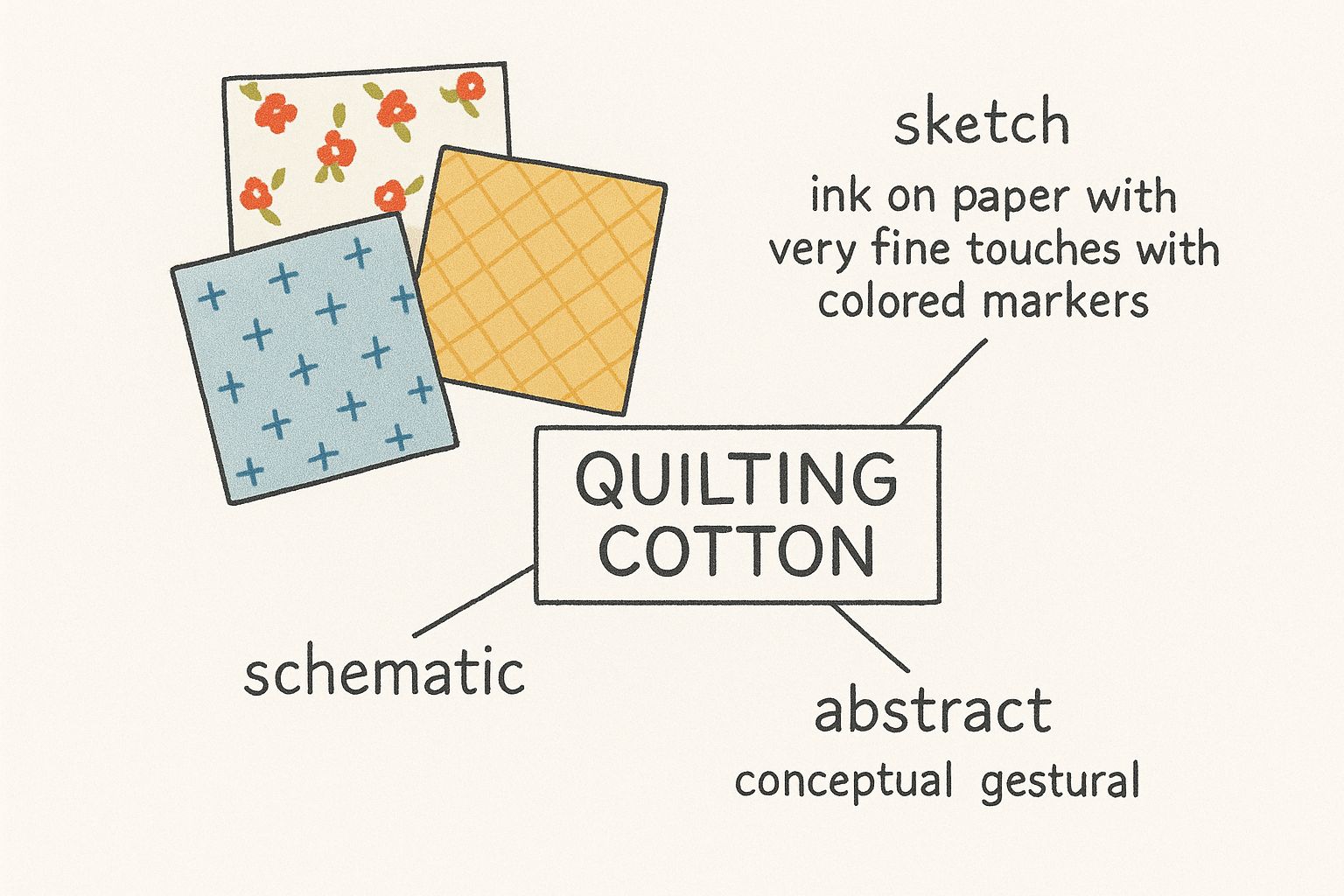
As you can see, it’s the combination of the right weight, a stable weave, and a quality finish that creates a fabric engineered to be both reliable and beautiful to work with.
Why Thread Count Matters
Finally, let's talk about thread count. While it’s not going to be as sky-high as luxury bedsheets, quality quilting cotton typically has a thread count of 60 threads per inch or higher. This dense weave is what gives the fabric its durability and that signature smooth, crisp finish.
That smooth surface isn't just for feel, either. It creates a perfect canvas for printing the vibrant, detailed designs we all love.
These three elements—weight, stability, and thread count—work together to create a fabric that's a dream to sew and built to last. It presses like a charm, resists fraying, and stands up to years of washing and loving.
Here at bsewinn.com, we believe that knowing your materials is the first step to mastering your craft. Our online classes and resources are all about helping you understand these unique qualities so you can create gorgeous projects with custom sewing machine designs that look polished for years to come.
Diving Into the Creative World of Quilting Cottons
When people talk about quilting cotton, they're not just talking about one single type of material. Oh no. They're talking about a whole vibrant universe of creative possibilities just waiting for you to jump in. This is really where your personal style starts to come alive—picking out the colors, patterns, and textures that will bring your project to life.
Getting to know the main players in this world is the first step in turning that vision in your head into something you can actually hold.
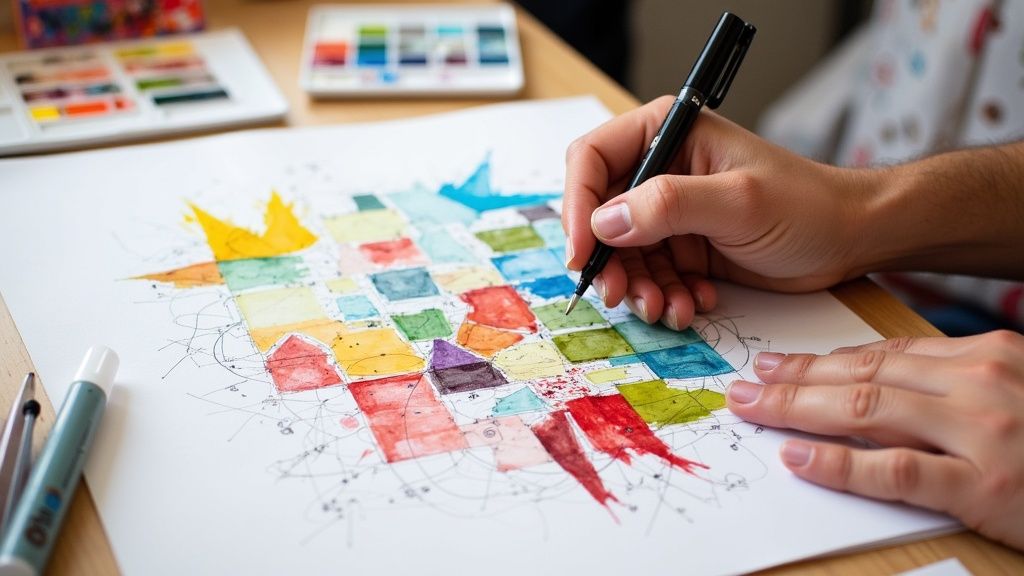
Whether you're piecing a sharp, modern quilt or sewing a sweet floral apron, the right fabric changes everything. Here at bsewinn.com, we get really excited about that creative freedom and love helping crafters find the perfect materials to get the job done. Our online classes provide the support you need to confidently turn these fabrics into beautiful, tangible items.
The Main Types of Quilting Cotton
Think of these different fabrics as your artistic palette. Each one has a unique purpose and brings a totally different vibe to your projects.
- Solids: These are the trusty workhorses of any fabric stash. Solids are incredibly versatile and just timeless. They can create a calm backdrop that makes your more intricate patterns really pop, or they can be the star of the show in a bold, minimalist design.
- Prints: From tiny florals and quirky novelty designs to crisp geometric shapes, printed quilting cottons are the storytellers. They inject personality and visual energy into a piece, and they're often the focal point of a quilt or garment.
- Batiks: Created with a special wax-resist dyeing technique, every single piece of batik fabric is a little work of art. They're known for their incredibly rich, saturated colors and unique marbled look, adding a ton of depth and a handcrafted feel to whatever you're making.
It's no surprise that with all these gorgeous options, the quilting world is booming. The quilting cotton market was valued at an impressive $2.5 billion in 2025, and it's expected to grow by 6% each year through 2033. It seems more and more people are falling in love with handcrafted home decor!
Learning how to pair these different fabric types is a skill that will take your projects from "nice" to "wow." It’s all about creating balance, contrast, and harmony with your choices.
For example, imagine creating a set of throw pillows. You could use a bold, large-scale floral print for the main pillow, then pull two of its accent colors to create coordinating pillows in solid fabrics. This is a tangible project you can replicate to practice color theory and construction skills. For more ideas on how to do this, you might love our guide on beautiful color combinations for quilts—it’s packed with inspiration for your next project.
Using Quilting Cotton for More Than Just Quilts
When you hear "quilting cotton," it’s easy to think its destiny is sealed right there in the name. Of course, it’s brilliant for quilts! But treating it as a one-trick pony is a huge missed opportunity. Its secret weapon is its incredible versatility, making it a dream fabric for a ton of other sewing projects.
The magic is in its structure—it's stable and crisp, which gives shape and durability to whatever you're making.
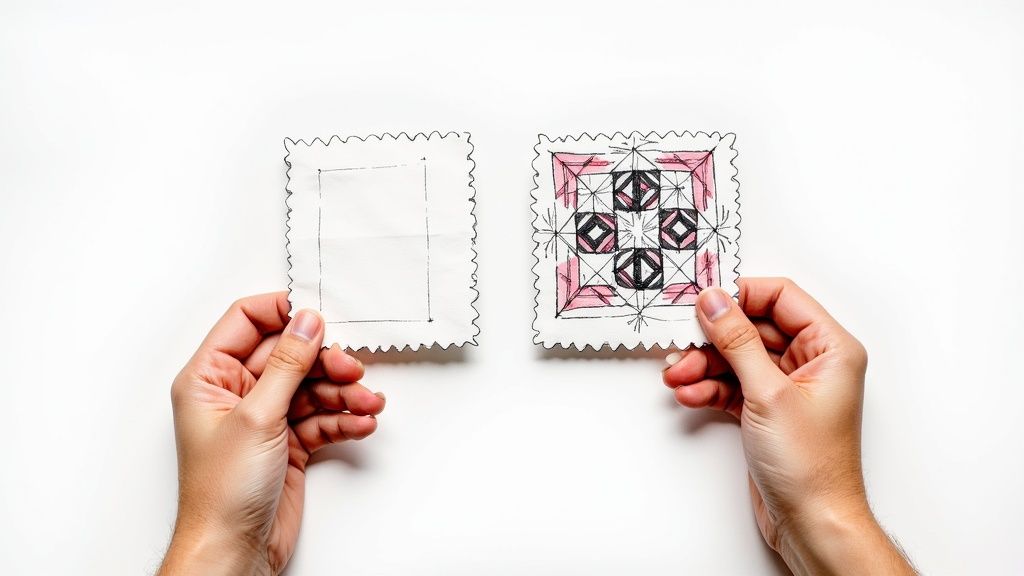
So, let's think beyond the blanket. This fabric is tough enough for the wear and tear of daily life but still soft enough to be comfy, opening up a whole world of possibilities on your sewing machine.
Expanding Your Crafting Horizons
So where else can this amazing fabric really shine? With its reliable medium weight and barely-there stretch, quilting cotton gives a surprisingly professional finish to so many different projects. Here are some tangible examples you can create:
-
Apparel: It’s an absolute star for structured blouses, cute A-line skirts, and breezy summer dresses that hold their shape without feeling stiff. A simple gathered skirt using a fun, novelty print is a perfect beginner project.
-
Bags and Accessories: That built-in durability makes quilting cotton a go-to for tote bags, zippered pouches, and clutches. Try making a library tote by sewing two large rectangles together and adding simple webbing straps.
-
Home Decor: Want to brighten up a room? Sew custom throw pillows, curtains, placemats, and table runners. A set of reversible placemats is a fantastic way to practice sewing straight lines and topstitching.
Here’s a non-negotiable tip for sewing clothes with quilting cotton: always pre-wash your fabric. It's 100% cotton, which means it will shrink a little. Giving it a wash before you cut ensures your finished garment fits perfectly, even after its first trip through the laundry.
This idea of adaptable crafting is at the heart of everything we do here at bsewinn.com. We design our online classes and extensive resources to give you the confidence to take a fantastic material like quilting cotton and apply your skills to countless projects. If you’re hunting for some ideas, check out our guide to easy sewing gift projects—they’re perfect for this versatile fabric.
How to Spot High-Quality Quilting Cotton
Walking into a fabric store can feel like a kid in a candy store—so many beautiful bolts of fabric, it's hard to know where to even begin! So, how can you be sure you're picking a high-quality quilting cotton that will make your project last? You don't have to be a textile expert. A few simple, hands-on tests can turn you into a savvy fabric shopper in minutes.
Simple Tests for Quality Fabric
The first test is all about feel. Go ahead and touch the fabric! A top-quality quilting cotton will feel smooth and substantial in your hands. It should have a tight, dense weave with a certain crispness to it, kind of like a brand-new set of high-end bedsheets. If it feels loose, flimsy, or overly coarse, it probably won't hold up to all the cutting, piecing, and washing your quilt will go through.
Next, give it a closer look. Unroll a little bit of fabric from the bolt and hold it up to a light. A good quilting cotton will be pretty opaque. If you can see right through it easily, that’s a red flag for lower-quality material that might fray or wear out way too fast.
Also, take a good look at the print itself. The colors should pop, and the lines of the design should be crisp and clear. If the pattern looks blurry or pixelated, it’s a sign of a cheaper printing process, and those dyes are more likely to bleed all over your hard work in the first wash.
Here at bsewinn.com, we believe that great projects start with a great foundation. Taking a moment to check your fabric ensures the time you spend creating results in a piece you can be proud of for years. We offer the support and training to help you every step of the way.
The US is a huge player in cotton production, churning out around 12.07 million bales in the 2023/2024 season alone. That raw material gets turned into billions of yards of fabric, which means we have plenty of amazing options to choose from. If you're curious, you can learn more about the fascinating journey of cotton from farm to fabric.
Your Top Questions About Quilting Cotton
Once you start diving into the world of quilting cotton, you're bound to have some questions. We all do! Getting these little details straight can make a huge difference in how your projects turn out.
Think of this as your personal cheat sheet. Whether you're puzzling over a bolt of fabric in the store or second-guessing a step at your sewing machine, these are the answers I wish I'd had when I started.
Can I Just Use Regular Cotton Instead of Quilting Cotton?
You can, but I wouldn't recommend it, especially if you're making a quilt. The real difference comes down to the fabric's structure. Quilting cotton has a higher thread count and a much tighter, more stable weave. It’s engineered that way to stop it from stretching and warping when you’re cutting and sewing all those little pieces.
If you try to use a standard apparel cotton, which is often thinner and has a looser weave, you'll likely end up frustrated. Your points won't match up, your blocks might look wonky, and the finished quilt just won't hold up as well over time. For anything that needs precision, sticking with quilting cotton is your best bet for a project you’ll be proud of.
Do I Really Need to Pre-Wash My Quilting Cotton?
Honestly? Yes. Pre-washing is one of those non-negotiable steps for me, and for good reason. It does three critical things:
- It pre-shrinks the fabric. This is the big one. It prevents all your hard work from puckering and distorting the first time you wash your finished quilt.
- It gets rid of excess dye. This simple step can save you from a heartbreaking laundry disaster where a bold color bleeds all over your lighter fabrics.
- It washes out finishing chemicals. Manufacturers use chemicals to give the fabric a crisp feel on the bolt. Washing them out leaves you with softer, cleaner fabric that’s a pleasure to work with.
My rule of thumb is this: if the project will ever be washed—like a quilt, a garment, or a tote bag—taking the time to pre-wash is non-negotiable. It’s insurance for your hard work.
What's the Difference Between Quilting Cotton and Canvas?
The main differences are weight and feel. Quilting cotton is a lovely medium-weight fabric that feels smooth and is a dream to press and sew. It’s flexible enough for intricate piecing without being flimsy.
Canvas, on the other hand, is a total workhorse. It’s much heavier, stiffer, and built for durability. It’s amazing for things like heavy-duty tote bags or home decor, but it's way too bulky for traditional quilting. Your home sewing machine would really struggle to get through the multiple layers needed for patchwork.
Why Is Quilting Cotton More Expensive?
That higher price tag is a direct reflection of higher quality at every step of the process. The good stuff starts with longer, superior cotton fibers, which are spun into a smoother, stronger thread. The fabric itself is woven more densely, goes through special finishing processes to give it a slight sheen, and is printed with high-quality, colorfast dyes that make the designs pop.
When you buy quilting cotton, you're investing in a material that's more reliable, durable, and beautiful to work with.
Ready to put all this knowledge to good use? At B-Sew Inn, we love empowering your creativity with everything from custom sewing machine setups to supportive online classes. Our goal is to provide the training and resources you need to confidently create anything you can imagine. Explore our collection and find inspiration for your next project today.


